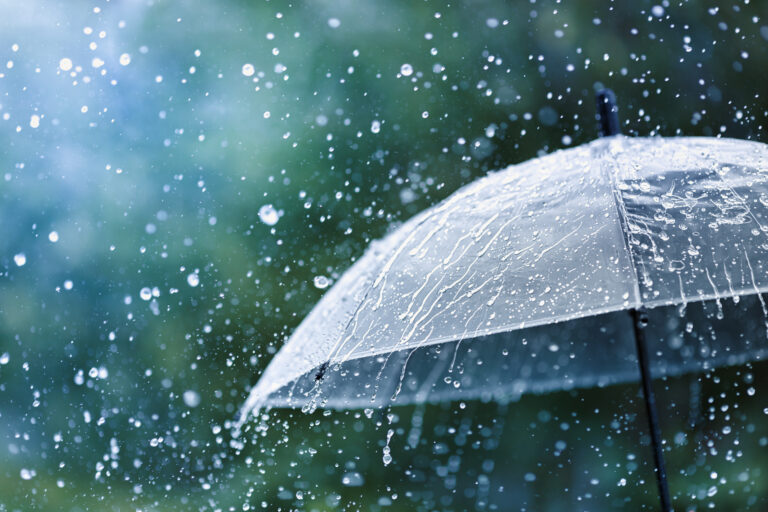Break out the plywood and tie down anything that isn’t nailed to the ground, we’re about to have a blow. From a young age, Bermudians become accustomed to “weather,” either through personal experience or the tall tales of storms past. If you happen to be on the island during hurricane season (June 1 to November 30), keep an ear out for common (and some not so common) terminology about the change in weather.
Strictly Bermudian
Before weather stations and Doppler radar, Bermudians predicted the onset of bad weather with shark oil barometers. If “de shark oil is all stirred up and cloudy,” a storm is likely on its way. Another “natural” tell? Silk spiders. Commonly known as the “hurricane spider,” this yellow-and- black arachnid usually spins its webs among the higher branches of trees. If you see their webs spun closer to the ground, expect the wind to start kicking up.
The scientific stuff
Bermuda is located in “Hurricane Alley,” the area of warm water in the Atlantic that stretches from the west coast of northern Africa to the east coast of Central America and Gulf Coast of the Southern United States. From our location in this “hurricane corridor,” we are subject to experience any number of potentially dangerous weather systems, usually during the latter half of the season. Regardless, our Bermuda Weather Service (BWS) monitors every system in the Atlantic, issuing a “storm watch” when sustained winds are expected to impact our area within 48 hours, or “storm warning,” when sustained winds are expected to impact the area within 36 hours.
“We use watches, warnings and threats to describe the impacts of tropical cyclones in our area,” explains Michelle Pitcher, Director of the BWS.
- No threat: issued in tropical update bulletins when a tropical cyclone has passed its closest point of approach to Bermuda and is moving away under the influence of a well defined upper southwesterly steering flow.
- Potential threat: issued in tropical update bulletins when the centre of a tropical system is expected to pass within 400 nautical miles of Bermuda within 72 hours.
- Threat: issued in tropical update bulletins when effects from a tropical system are possible within 72 hours and/or the cyclone centre is expected to pass within 100 nautical miles of Bermuda in the next 72 hours.
Once a threat is issued, it’s time to start prepping—for the hurricane party! There’s nothing like sipping on a dark n’ stormy while you watch the wind and rain whip it up in the backyard. Just remember: though you may be tempted to head out and explore the aftermath, stay inside! At least until you’re sure the eye has passed.
The “eye” of the storm is the centre of the cyclone. It has calm to light winds and is often cloudless. “Think of water swirling down a drain–the centre is empty,” Pitcher explains. “The strongest winds and some of the most severe weather can be found in the eye wall. Not knowing exactly how long it will take for the eye to pass means you could be outside when the full strength of the cyclone returns.”
It’s rare that the eye will pass over the island and we experience the devastating effects of the “eyewall,” defined as the unbroken, vertical wall of clouds where the wind is so strong that the air rises faster, and with more force, than anywhere else in a hurricane, producing intense rain and damaging winds.
“A rough look at the data shows we have had 15 cyclones come within 50 nautical miles of Bermuda from 2010 to 2020,” says Pitcher. “Between 2000 to 2010 there were nine cyclones that passed within 50 nautical miles of Bermuda. From 1990 to 2000 there were five cyclones. While not all of these were a direct hit, 50 nautical miles is close enough for Bermuda to have some significant impacts.”
A hurricane’s destructive winds and rains cover a wide swath. Hurricane-force winds can extend outward to more than 150 miles depending on the size of the storm. The area over which tropical storm-force winds occur is even greater, ranging as far out as almost 300 miles from the eye of a large hurricane.
Boat owners will want to pay close attention to tide warnings, especially listening out for news on “storm surge” and “storm tide.”
- Storm surge: an abnormal rise of water generated by a storm, over and above the predicted astronomical tide.
- Storm tide: the water level rise during a storm due to the combination of storm surge and the astronomical tide.
Did you know?
There is a high-pressure system over the Atlantic Ocean called the “Bermuda High” that has the ability to significantly impact the strength and track of tropical systems in the Atlantic basin. According to accuweather.com: “The clockwise circulation around the high-pressure system is what helps direct the path of tropical systems and can determine where they make landfall. The impacts of the Bermuda high are so significant that it can cause a hurricane to move westward and target Louisiana, move eastward and target the East Coast, or anything in between.”
Make your hurricane list, check it twice
Like our sturdy stone houses, Bermudians are built to weather any storm, but a deeper understanding of tropical storms and hurricanes can help alleviate stress in these situations. As the experts at the BWS say: “Prepare early, refresh your supplies, and have a plan in place before the start of the Atlantic hurricane season. Tropical cyclones can occur any time of the year. The season covers the most likely time of tropical cyclone development.”
Check www.weather.bm and www.nhc.noaa.gov for the latest information on tropical cyclones.
Prepare for the worst, hope for the best, and review your plan often. Follow advice and guidelines set out by the Emergency Measures Organization at https://www.gov.bm/department/emergency-measures-organisation.

